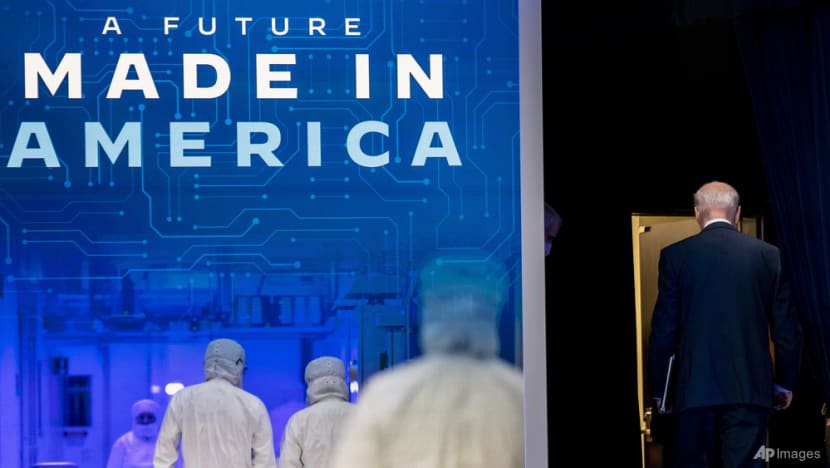US midwest grapples with job losses to China as midterm elections approach
Republican and Democratic candidates are pledging tough stances on China, hoping to woo voters who see China as a threat to national and job security.

President Joe Biden leaves after speaking about Intel's announcement to invest in an Ohio chip making facility, at the White House Campus in Washington, Jan 21, 2022. (File photo: AP/Andrew Harnik)
BUCYRUS, Ohio: A few weeks ago, GE Lighting turned off its lights for the last time in its factory in the town of Bucyrus, after having outlasted every other lamp plant of its kind in the US.
Jobs in the industry had increasingly moved overseas, notably to China, and the closure of this plant would leave another 150 workers jobless.
In the town of less than 15,000 residents, job losses are keenly felt among the community, which wants politicians to do more to keep jobs in the US.
“It affects every family in one way or another around here. So it's a sad loss. We've lost many different companies over the past decade,” said Bucyrus resident Rebecca Strickland.
Once a powerhouse of midwest manufacturing, Ohio is struggling to find its place in a post-industrial age.
As factories close and more manufacturing moves abroad, China has become a campaign issue for politicians who want to win votes in America’s former industrial heartlands.
“It's hard to compete with China. I mean, China doesn't have the regulations that we have,” said Bucyrus resident Jimmy Benton, who added that wages are lower in China.
AMERICANS’ VIEW OF CHINA AT ALL-TIME LOW
When asked if his vote would be swayed by a political candidate’s stance on China, Mr Benton replied: “Yeah, it (would). Absolutely. Yes.”
He said that the Democrats – currently in control of the Senate, the House of Representatives, and the presidency – are not “doing what they need to do”, and added that the Republicans are likely to do a better job.
Candidates from both parties are hoping to woo voters by pledging tough stances on China, amid its rising unpopularity among Americans who see the country as a threat to their national security and job security.
In April, a Pew Research Center survey showed that the number of Americans with an unfavourable view of China had increased to a record high of 82 per cent.
Ohio Democratic Senate hopeful Tim Ryan is one such candidate with a strong rhetoric on China, and discusses the East Asian country at every stop on his campaign trail.

One of his key attacks on his Republican opponent JD Vance, who is backed by former president Donald Trump, paints him as weak on China.
"You don't have the guts to take on China...how can you represent Ohio?" he asked Mr Vance in his campaign video.
CHINA WEIGHS HEAVY IN OHIO SENATE BATTLE
Ohio is a key battleground state in the upcoming midterm elections - it is among a handful of states that could decide if the Republicans would take control of Congress. The White House is well aware of the stakes, with President Joe Biden having visited the state seven times since taking office.
Ohio State University Professor Emeritus Herb Asher said that given the tightness and significance of the race in Ohio, it is not a surprise that China has become a major part of the discourse.
"China is a major competitor. China is a major military power. It's a major diplomatic power. It's a major economic power,” he said. “I think that's perfectly legitimate – even if it's exaggerated – to say we have to do a better job in terms of bringing jobs back to the United States.”
He added that with many well-paying, unionised jobs lost over the years, politicians with pro-business and pro-job policies can be appealing to voters in the state.
THE WAR ON SEMICONDUCTORS
Since 2001, its trade deficit with China has cost the US 3.7 million jobs, with most of the losses stemming from manufacturing, according to a 2020 report by think tank Economic Policy Institute.
The US government has tried recouping some of those losses and generating a manufacturing revival. In September, President Biden broke ground on chip-maker Intel’s new US$20 billion plant in Ohio.
Recent laws have also been passed to keep advanced semiconductor manufacturing within the US, and in part protect its technology from China.
The Biden administration in October imposed new export curbs to restrict China’s access to advanced semiconductors which rely on US technology.
“Essentially it’s a strategy to (restrict) China’s ability to innovate and become more technologically advanced, particularly in semiconductors,” said Dr Yukon Huang, senior fellow of the Asia Program at think tank Carnegie Endowment for International Peace.
Dr Huang told CNA’s Asia First on Thursday (Nov 3) that the move is expected to have a negative impact throughout Asia, as high-tech activities and transfer of technological information will be impeded.
The US currently accounts for just 12 per cent of the world’s semiconductor manufacturing. In contrast, East Asia produces about 75 per cent of the world’s semiconductor chips.
Dr Huang said that while the US is pouring billions of dollars into the race to boost domestic semiconductor manufacturing, the amount is small compared to China, and the overall market is getting too saturated.
“The reality is that no country or region can dominate the production of semiconductors. We’re already in a period where there is excess supply of semiconductors, and we are going to see more money poured in at a time when it is less profitable to produce them,” he said.






















